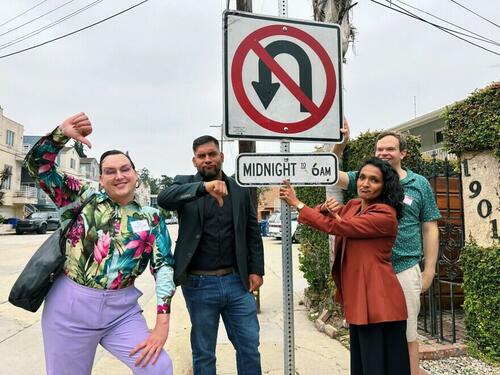LA City Council Removes U-Turn Signs In Gay Neighborhood Because They Are “Homophobic”
Another bizarre virtue signal just in time for pride month. Street signs that LA officials said previously targeted LGBT community members were taken down from a Silver Lake neighborhood this week. The signs that read “No Cruising” and prohibited U-turns were installed in 1997 when neighbors allegedly complained about gay men stalking back and forth in vehicles looking for “dates” in certain residential areas.
BREAKING: LA City Council members have removed “No U-Turn” traffic signs in a gay neighborhood.
They say the signs were homophobic.
No, this is not satire. pic.twitter.com/yadflyo588
— End Wokeness (@EndWokeness) June 14, 2024
In other words, the signs interfere with the gay pastime of “cruising” (sexual solicitation). Whether or not they were actually posted specifically to ward off gay people is not confirmed, but the simple act of obstructing LGBT people from doing whatever they want to do is now considered “homophobia” by progressives.
“For me, growing up in South Central Los Angeles, cruising had a very different meaning. It usually meant folks in their lowriders or their cars, a lot of hip-hop music, just going up down Crenshaw Boulevard,” Council member Soto-Martinez said. “But here in Silver Lake, cruising, of course, meant something very different. It meant an opportunity for the LGBT community to try to find human connection and intimacy and to be able to express themselves in a society at the time that was not very welcoming to the LGBT community.”
The history of “cruising” in the gay community had very little to do with dating and far more to do with anonymous encounters as well as prostitution. With the advent of more socially accepted gay society in the US in the 1970s, a cultural problem of sexual solicitation and lewdness arose in public bathrooms and public parks in cities across America. The habit naturally attracted crime to certain areas and is even cited as one of the primary causes for the rapid spread of AIDS in the early 1980s.
The problem was apparently so bad in the neighborhood of Silver Lake that residents were compelled to put traffic restrictions in place to prevent people from driving back and forth on their street all day soliciting for sex. Keep in mind, such laws also exist in places where straight prostitution and solicitation is common.
LGBT advocates argue that cruising encounters were a necessity due to social stigma and laws against homosexuality, but such issues did not exist in the late 1990s, especially in liberal LA. The bottom line? Hedonism is a consistent feature of gay society regardless of the laws or how much social acceptance is in vogue. Cruising is not a necessary behavior, it’s a fetish.
If residents of any neighborhood were faced with their area becoming a hot spot for solicitation and prostitution, gay or straight, it’s reasonable for them to do whatever they can to make it stop.
Tyler Durden
Fri, 06/14/2024 – 18:30

